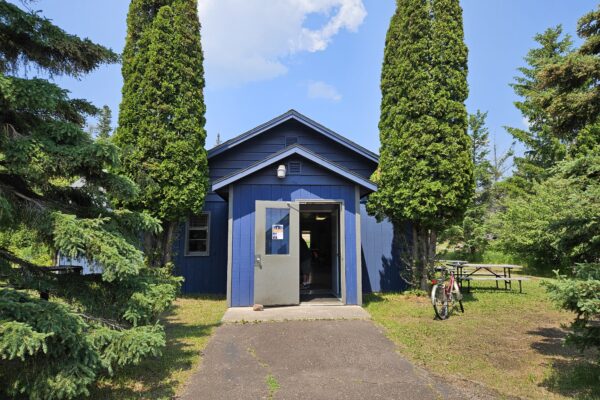Grand Marais officials discuss ‘foul smell’ from wastewater treatment facility and explore solutions
What is the source of the “smell” from the wastewater treatment facility in Grand Marais?
As it turns out, it’s a complex answer. “There are a thousand little pieces to this puzzle,” said Neil Hanson, wastewater superintendent.
The thousand little pieces include aging infrastructure, lack of adequate oxygen, flow volumes, weather conditions, the proximity of the facility to town, and general operations of the plant, to name a few.
The Grand Marais wastewater treatment facility was constructed in the 1940s. The last major infrastructure improvements to the facility were completed more than 30 years ago, in 1988. The plant was initially designed for a capacity equivalent of up to 3,500 people. That means the facility was designed to handle more residents moving to the area, as the population of Grand Marais during the 1990 census count was 1,171.
“Our community really hasn’t grown a lot since then,” said Mike Roth, city administrator. “So it still has quite a bit of excess capacity.”
During the most recent count in 2020, the population of Grand Marais was 1,337. Despite community concerns over growing capacity issues due to increased tourism and commercial business in the city, Roth and Hanson insist that isn’t the root cause of the unpleasant odor that can linger along Highway 61 and the east end of Grand Marais.
“The smell is not related to capacity issues at all. We don’t have capacity issues at the plant,” Roth said. “It’s capable of handling quite a bit more than we’re asking it to right now. So the smells are more a factor of just the regular operations of the plant.”
Stephen Mikkelson, a communications specialist with the Minnesota Pollution Control Agency, said it is unlikely that an increase in tourism and commercial businesses would contribute to the odor problem coming from the Grand Marais facility.
“The plants are designed to handle those flows from facilities to accommodate tourists and commercial businesses,” he said.
While the wastewater treatment facility does experience an increase in volume during the busy summer months, the difficulty lies with monitoring the large inflows and providing sufficient aeration, according to city and state officials who spoke with WTIP for this story.
Wastewater treatment plants require sufficient levels of oxygen to break down organic matter. If more oxygen is consumed than is produced, dissolved oxygen (DO) levels decline.
“Our limitations at the wastewater plant currently is the oxygen that we can supply to manage the different inflows of the food (organic matter) that comes in,” said Tom Nelson, the former wastewater superintendent for Grand Marais. Nelson made the comment during a July city council meeting.
In August, city officials met with an engineering firm to help them solve the problem with the foul odor coming from the wastewater treatment facility.
The firm, AE2S, which is based in Duluth, was hired to explore solutions for upgrading the wastewater treatment facility in Grand Marais. During the Aug. 3 meeting, Scott Schaefer, the practices director with the AE2S, outlined areas of concern and provided potential solutions for the city.
“You’re getting tourism coming through,” he said. “A lot more people are in town, which directly translates into an additional load onto the facility that needs more air.”
Schaeffer said that structural concrete issues in the oxidation ditches were identified six years ago and remain an issue.
“You’re kind of already riding the line, and there’s not much room for error,” he said.
In addition to the wastewater treatment plant experiencing increased volume in the summer months, two factors compound the potential for a foul smell to arise: water temperatures and wind conditions.
Nelson said there is a seasonal aspect to the odor as well.
“It happens worse in the summertime because the amount of oxygen that you can store in water is reduced,” Nelson said.
Hanson said that the wastewater facility conducts its general operations of ‘wasting’ at specific times of the day, and the wind is not always in their favor. He explained that southwest and east winds tend to amplify the smell onto the surrounding land.
The Grand Marais wastewater treatment facility is one of many facilities along the North Shore that experience this problem.
“Wastewater treatment plants, in general, do produce odor,” said Luke Heikkila, Two Harbors wastewater superintendent. Heikkila said the Two Harbors plant does experience a foul smell from time to time.
Heikkila said numerous factors can contribute to a facility emitting an odor, and the reason will “differ from facility to facility.” For example, he said it might depend on the type of industries in the town, the flavor of the biosolids product, and wind conditions.
While the Two Harbors facility tries its best to mitigate the foul smell, Heikkila said there’s only so much you can do. However, he said there are steps that wastewater treatment facilities can take to alleviate a foul smell. The first is increasing aeration methods to increase oxygen levels. The second is to monitor and control when and where certain entities or industries are dumping.
“Cities have the authority through their wastewater permit to control its users, whether commercial, industrial, or domestic,” Mikkelson said.
Currently, the wastewater treatment facility has an industrial use permit with G&G Septic Services. Roth said G&G Septic Services processes the waste they collect from across the county at their plant in the Cedar Grove Business Park and then uses the Grand Marais wastewater treatment facility to treat it.
“We have a lot of flexibility to work with them on what sorts of things we want them not to put in and the time of year and how much we’re willing to take at any given time,” said Roth. He added that G&G has some holding capacity at their plant so they can control at which speed the waste gets into the Grand Marais system.
“It’s been a good partnership between the city and G&G Septic,” Roth said.
During the July 27 city council meeting, Nelson said that it would be helpful to look into other commercial or industrial businesses to analyze and isolate potential causes “that might disrupt the quality of water that we are putting out to the lake.”
While there are numerous other avenues for the Grand Marais wastewater treatment facility to explore to solve the ‘foul smell’ problem, the process of doing so is complex and multi-faceted.
In December, the city will resume conversations with the engineering firm AE2S. The firm will present a report at the public utility commission meeting that outlines various risk factors if upgrades are not completed, the benefits of specific improvements, and the project’s overall cost.
“Wastewater treatment plants are some of the most expensive investments that small communities end up having to make. They are designed to be long-term investments, but it’s hard to ask a community now to pay for a 50-year improvement,” Roth said.
He added that the city is exploring financial assistance from the state and federal government for wastewater treatment facility upgrades to help alleviate the financial burden on local taxpayers.
In the meantime, Hanson said, “We’re trying to implement small changes and things that we personally can do.” However, the road ahead is long, and it seems that Grand Marais residents and visitors will have to deal with the smell for the foreseeable future.














